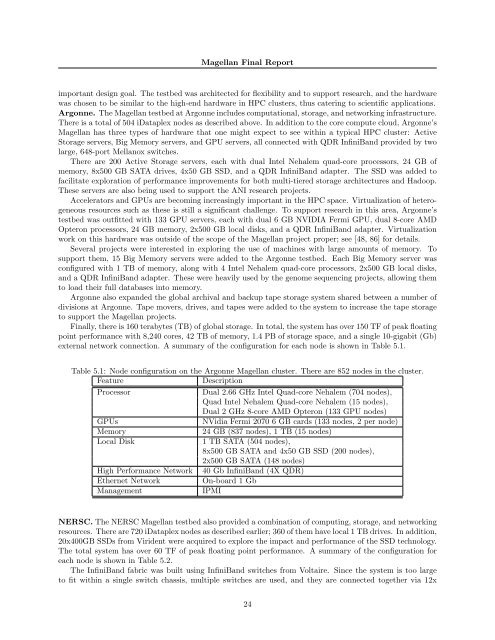Magellan Final Report - Office of Science - U.S. Department of Energy
Magellan Final Report - Office of Science - U.S. Department of Energy
Magellan Final Report - Office of Science - U.S. Department of Energy
You also want an ePaper? Increase the reach of your titles
YUMPU automatically turns print PDFs into web optimized ePapers that Google loves.
<strong>Magellan</strong> <strong>Final</strong> <strong>Report</strong><br />
important design goal. The testbed was architected for flexibility and to support research, and the hardware<br />
was chosen to be similar to the high-end hardware in HPC clusters, thus catering to scientific applications.<br />
Argonne. The <strong>Magellan</strong> testbed at Argonne includes computational, storage, and networking infrastructure.<br />
There is a total <strong>of</strong> 504 iDataplex nodes as described above. In addition to the core compute cloud, Argonne’s<br />
<strong>Magellan</strong> has three types <strong>of</strong> hardware that one might expect to see within a typical HPC cluster: Active<br />
Storage servers, Big Memory servers, and GPU servers, all connected with QDR InfiniBand provided by two<br />
large, 648-port Mellanox switches.<br />
There are 200 Active Storage servers, each with dual Intel Nehalem quad-core processors, 24 GB <strong>of</strong><br />
memory, 8x500 GB SATA drives, 4x50 GB SSD, and a QDR InfiniBand adapter. The SSD was added to<br />
facilitate exploration <strong>of</strong> performance improvements for both multi-tiered storage architectures and Hadoop.<br />
These servers are also being used to support the ANI research projects.<br />
Accelerators and GPUs are becoming increasingly important in the HPC space. Virtualization <strong>of</strong> heterogeneous<br />
resources such as these is still a significant challenge. To support research in this area, Argonne’s<br />
testbed was outfitted with 133 GPU servers, each with dual 6 GB NVIDIA Fermi GPU, dual 8-core AMD<br />
Opteron processors, 24 GB memory, 2x500 GB local disks, and a QDR InfiniBand adapter. Virtualization<br />
work on this hardware was outside <strong>of</strong> the scope <strong>of</strong> the <strong>Magellan</strong> project proper; see [48, 86] for details.<br />
Several projects were interested in exploring the use <strong>of</strong> machines with large amounts <strong>of</strong> memory. To<br />
support them, 15 Big Memory servers were added to the Argonne testbed. Each Big Memory server was<br />
configured with 1 TB <strong>of</strong> memory, along with 4 Intel Nehalem quad-core processors, 2x500 GB local disks,<br />
and a QDR InfiniBand adapter. These were heavily used by the genome sequencing projects, allowing them<br />
to load their full databases into memory.<br />
Argonne also expanded the global archival and backup tape storage system shared between a number <strong>of</strong><br />
divisions at Argonne. Tape movers, drives, and tapes were added to the system to increase the tape storage<br />
to support the <strong>Magellan</strong> projects.<br />
<strong>Final</strong>ly, there is 160 terabytes (TB) <strong>of</strong> global storage. In total, the system has over 150 TF <strong>of</strong> peak floating<br />
point performance with 8,240 cores, 42 TB <strong>of</strong> memory, 1.4 PB <strong>of</strong> storage space, and a single 10-gigabit (Gb)<br />
external network connection. A summary <strong>of</strong> the configuration for each node is shown in Table 5.1.<br />
Table 5.1: Node configuration on the Argonne <strong>Magellan</strong> cluster. There are 852 nodes in the cluster.<br />
Feature<br />
Description<br />
Processor<br />
Dual 2.66 GHz Intel Quad-core Nehalem (704 nodes),<br />
Quad Intel Nehalem Quad-core Nehalem (15 nodes),<br />
Dual 2 GHz 8-core AMD Opteron (133 GPU nodes)<br />
GPUs<br />
NVidia Fermi 2070 6 GB cards (133 nodes, 2 per node)<br />
Memory<br />
Local Disk<br />
High Performance Network<br />
Ethernet Network<br />
Management<br />
24 GB (837 nodes), 1 TB (15 nodes)<br />
1 TB SATA (504 nodes),<br />
8x500 GB SATA and 4x50 GB SSD (200 nodes),<br />
2x500 GB SATA (148 nodes)<br />
40 Gb InfiniBand (4X QDR)<br />
On-board 1 Gb<br />
IPMI<br />
NERSC. The NERSC <strong>Magellan</strong> testbed also provided a combination <strong>of</strong> computing, storage, and networking<br />
resources. There are 720 iDataplex nodes as described earlier; 360 <strong>of</strong> them have local 1 TB drives. In addition,<br />
20x400GB SSDs from Virident were acquired to explore the impact and performance <strong>of</strong> the SSD technology.<br />
The total system has over 60 TF <strong>of</strong> peak floating point performance. A summary <strong>of</strong> the configuration for<br />
each node is shown in Table 5.2.<br />
The InfiniBand fabric was built using InfiniBand switches from Voltaire. Since the system is too large<br />
to fit within a single switch chassis, multiple switches are used, and they are connected together via 12x<br />
24

















